In the vast prehistoric world, dinosaurs dominated land environments for over 165 million years. However, not all dinosaurs were confined to terrestrial habitats. Recent paleontological discoveries have revealed that several dinosaur species possessed adaptations that enabled them to navigate aquatic environments with remarkable proficiency. From specialized limbs to streamlined bodies, these swimming dinosaurs challenge our traditional understanding of these magnificent creatures. This article explores ten dinosaurs that broke the terrestrial stereotype and conquered the prehistoric waters, showcasing the incredible diversity and adaptability of dinosaurian evolution.
Spinosaurus: The Swimming Predator

Spinosaurus aegyptiacus stands as perhaps the most famous aquatic dinosaur, revolutionizing our understanding of dinosaur ecology when research in 2014 revealed its truly semi-aquatic nature. This massive theropod, stretching up to 50 feet long, possessed a suite of adaptations perfect for an aquatic lifestyle. Its most distinctive feature was densely packed bones in its feet and tail that would have provided tremendous propulsion in water. Unlike other theropods, Spinosaurus had shorter hind limbs relative to its forelimbs, suggesting it moved on all fours and would have been awkward on land but efficient in water. Its crocodile-like snout housed conical teeth ideally suited for catching slippery fish, and pressure-sensitive receptors similar to those in crocodilians likely helped it detect prey movements underwater. The famous sail along its back may have served multiple functions, including thermoregulation after cold water immersion or display during mating rituals.
Halszkaraptor: The Duck-Like Dinosaur
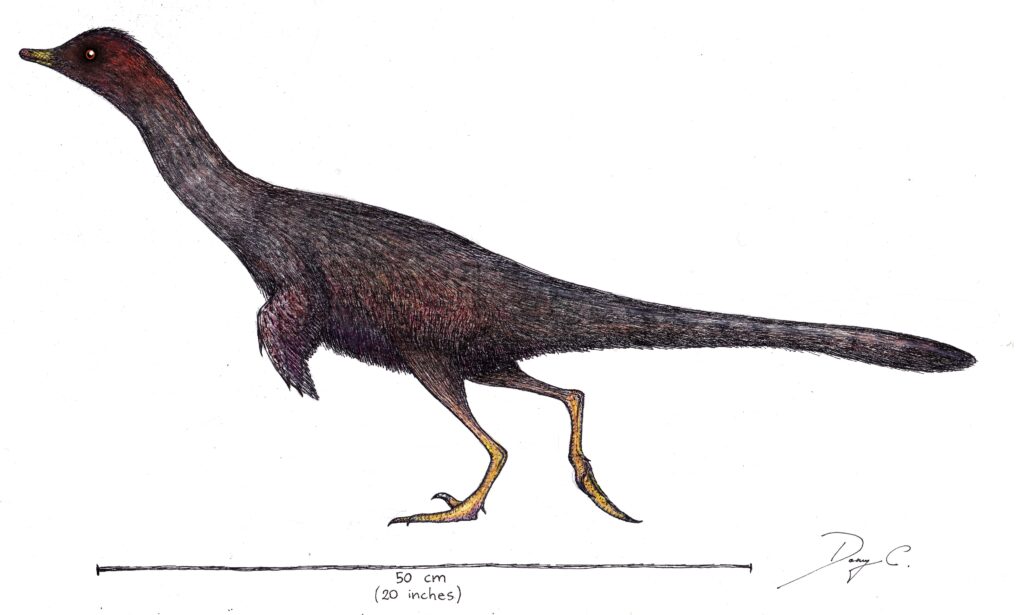
Discovered in Mongolia’s Gobi Desert, Halszkaraptor escuilliei represents one of the most bizarre adaptations to aquatic life among dinosaurs. This small dromaeosaurid from the Late Cretaceous period, about 75 million years ago, combined features never before seen together in a dinosaur. Its forelimbs were modified into flipper-like appendages resembling those of modern penguins, providing evidence for swimming capabilities. Halszkaraptor’s neck was long and flexible, similar to those of modern waterfowl, allowing it to hunt effectively in shallow waters. Its snout contained numerous tiny teeth and was densely packed with sensory receptors similar to those found in crocodiles, suggesting it could detect prey underwater through pressure changes. Most remarkably, CT scans of Halszkaraptor fossils revealed a body posture reminiscent of modern waterfowl, supporting the hypothesis that this unusual dinosaur lived a semi-aquatic lifestyle, potentially feeding on small fish and crustaceans in freshwater environments.
Hesperornis: The Diving Bird-Like Dinosaur
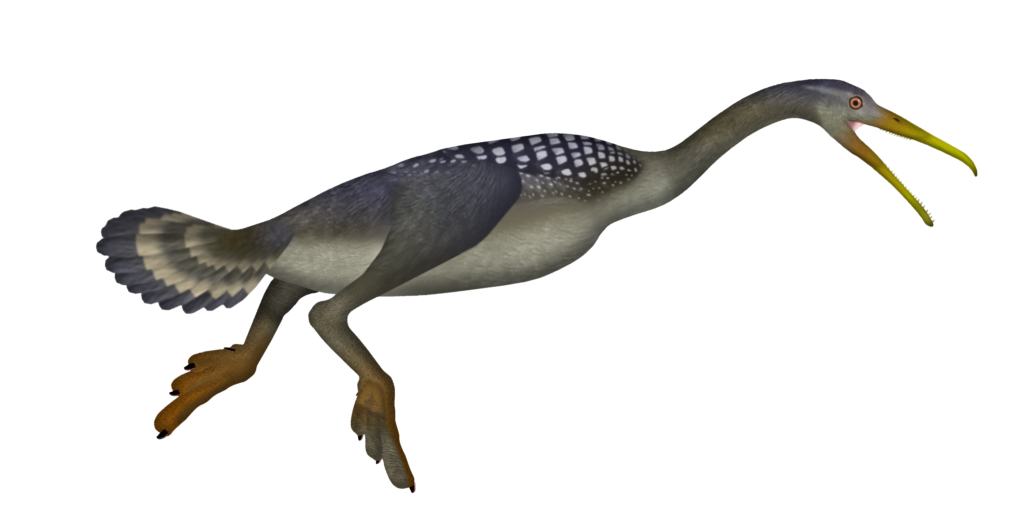
Though technically an avian dinosaur, Hesperornis represents a fascinating evolutionary branch that returned to an aquatic lifestyle. This flightless diving bird from the Late Cretaceous period grew up to 6 feet long and possessed highly specialized adaptations for underwater propulsion. Its wings had evolved into tiny, vestigial structures, while its powerful legs ended in lobed toes that functioned like efficient flippers for swimming. Skeletal analysis reveals dense bones that would have reduced buoyancy, allowing Hesperornis to dive deeply with minimal effort – a feature shared with modern diving birds. Its beak contained numerous sharp, backward-pointing teeth set in a groove rather than individual sockets, perfectly adapted for catching slippery fish that it would swallow whole. Fossil evidence suggests Hesperornis inhabited the Western Interior Seaway that divided North America during the Late Cretaceous, where it likely hunted fish like modern loons and grebes, representing a highly successful aquatic adaptation among dinosaur descendants.
Liaoningosaurus: The Armored Swimmer

Challenging the notion that heavily armored dinosaurs couldn’t swim effectively, Liaoningosaurus paradoxus represents a remarkable adaptation among ankylosaurs. This small armored dinosaur from Early Cretaceous China (approximately 122 million years ago) measured only about 34 centimeters in length, making it one of the smallest known ankylosaurs. What makes Liaoningosaurus extraordinary is the 2016 discovery of specimens containing fish remains in their abdominal cavities, strongly suggesting they actively hunted aquatic prey. Unlike typical ankylosaurs, Liaoningosaurus possessed a flattened shell-like armor that would have provided both protection and potential buoyancy control. Its limbs show modifications consistent with paddling adaptations, with front limbs potentially evolved for more efficient underwater movement. Most remarkably, its gastralia (belly ribs) formed a basket-like structure similar to those seen in some aquatic reptiles, potentially aiding in buoyancy control or lung capacity regulation during dives. This evidence collectively suggests Liaoningosaurus was a specialized ankylosaur that evolved to exploit aquatic resources in prehistoric lake environments.
Suchomimus: The Crocodile Mimic

Suchomimus tenerensis, whose name means “crocodile mimic,” provides compelling evidence for semi-aquatic behavior among spinosaurid dinosaurs. This 36-foot-long theropod from Early Cretaceous Niger (approximately 112 million years ago) possessed a remarkably crocodile-like snout filled with conical teeth ideal for catching fish. Its powerful forelimbs ended in large curved claws that paleontologists believe were perfect tools for “fishing” – potentially hooking and grasping large prey from the water’s edge. Anatomical studies reveal that Suchomimus had forward-positioned nostrils that would have allowed it to breathe while partially submerged, similar to modern crocodilians. Its center of gravity and weight distribution suggest it could navigate shallow water environments efficiently, potentially wading through rivers and lakes to hunt. The habitat where Suchomimus fossils have been discovered was a vast river system teeming with fish, including the massive coelacanth Mawsonia, which likely constituted a significant portion of this dinosaur’s diet, supporting the theory that Suchomimus spent considerable time hunting in aquatic environments.
Baryonyx: The European Fisher
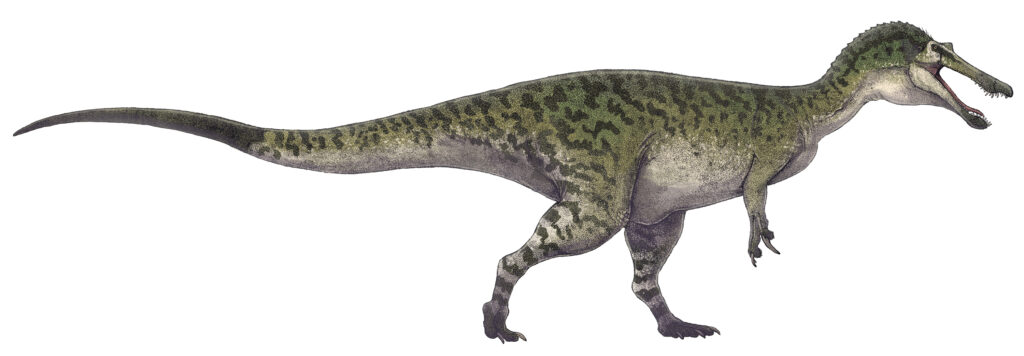
Baryonyx walkeri represents one of the strongest cases for semi-aquatic dinosaurs from European fossil records, providing direct evidence of fishing behavior among theropods. This 30-foot spinosaurid from Early Cretaceous England (approximately 125 million years ago) made paleontological headlines when its holotype specimen was discovered with fish scales and juvenile Iguanodon remains in its stomach region, offering rare direct evidence of diet. Its most distinctive feature was an enormous curved claw on each hand, measuring around 12 inches long, which likely functioned as specialized fishing tools for gaffing prey from water. Baryonyx possessed a long, slender, crocodile-like snout with over 96 teeth, twice the number found in most theropods, creating an effective fish-catching apparatus. Isotopic analysis of its teeth reveals values consistent with significant time spent in aquatic environments, matching patterns seen in modern semi-aquatic predators. The anatomical structure of its skull, particularly the positioning of its nostrils and jaw mechanics, suggests it could submerge its snout while hunting, similar to modern herons or crocodiles, establishing Baryonyx as a specialized fisher among dinosaurs.
Deinocheirus: The Humpbacked Swimmer

Initially known only from massive arms discovered in 1965, complete specimens of Deinocheirus mirificus revealed in 2014 showed this dinosaur defied all expectations, including evidence of aquatic behavior. This bizarre theropod from Late Cretaceous Mongolia grew to over 36 feet long and possessed several adaptations suggesting semi-aquatic tendencies. Its unusually wide, flat feet would have prevented sinking in soft, muddy substrates near water, functioning similar to snowshoes. Fish remains discovered in the stomach region of a specimen provide direct evidence of aquatic feeding, supported by its duck-like bill that would have been effective for scooping through shallow water or soft mud for aquatic organisms. Most intriguingly, Deinocheirus had elongated neural spines creating a distinctive sail or hump that stored fat reserves, potentially supporting extended time in water where terrestrial food might be less available. The combination of these features, along with isotopic studies of its remains matching wetland environments, strongly suggests Deinocheirus frequented aquatic habitats, potentially wading through shallow lakes and streams of prehistoric Mongolia to feed on fish, plants, and small aquatic creatures.
Ceratosaurus: The Amphibious Predator
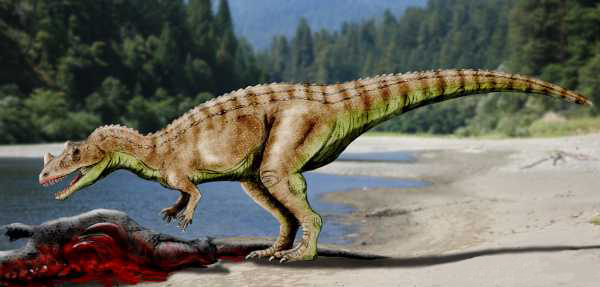
Among the more unexpected dinosaurs with potential swimming abilities, Ceratosaurus nasicornis shows several anatomical features suggesting comfort in aquatic environments. This medium-sized theropod from Late Jurassic North America (approximately 150 million years ago) is distinguished by the large horn on its snout and smaller horns above each eye. Unlike most theropods, Ceratosaurus possessed an unusually deep, laterally compressed tail that resembles those of modern crocodilians, providing an effective propulsion mechanism for swimming. Its relatively short limb, bs compared to other theropods of similar s, size would have created less drag in water, while its body proportions suggest it may have employed a crocodile-like swimming motion. Most compellingly, Ceratosaurus fossils are frequently found in ancient riverbed and floodplain deposits, indicating a habitat preference connected to water bodies. Skeletal studies reveal unusually dense bones, particularly in its tail region, which would have provided improved buoyancy control while swimming, collectively suggesting that the Ceratosaurus may have been an ambush predator that utilized water to hunt or escape larger predators like the Allosaurus.
Microraptor: The Four-Winged Swimmer

Microraptor gui, already famous for its four-winged gliding capabilities, has recently been recognized as having potential aquatic abilities as well, making it one of the most versatile small dinosaurs known. This crow-sized dromaeosaurid from Early Cretaceous China (approximately 120 million years ago) possessed long flight feathers not only on its arms but also on its legs, creating four wing-like surfaces. Recent studies examining the Microraptor’s foot structure revealed features consistent with aquatic birds, including relatively long central toes that may have facilitated movement through water. Analysis of preserved stomach contents has revealed fish remains, providing direct evidence that the Microraptor hunted aquatic prey. Most intriguingly, experiments with models suggest the Microraptor could have used its feathered limbs to “row” across water surfaces similar to modern water birds, potentially taking off from water into gliding flight. The environments where Microraptor fossils have been discovered were prehistoric lake systems rich in fish, suggesting these small dinosaurs may have evolved as versatile predators capable of hunting in multiple domains – air, land, and water – representing one of the most adaptable small dinosaurs yet discovered.
Austroraptor: The Wading Hunter

Austroraptor cabazai, discovered in Argentina, represents one of the most specialized dromaeosaurids adapted for semi-aquatic hunting. This 16-foot predator from Late Cretaceous Argentina (approximately 70 million years ago) possessed unusually short arms for a dromaeosaurid, but an extremely long snout filled with numerous small, unserrated teeth perfect for catching slippery aquatic prey. Its skull structure bears remarkable similarities to modern herons and other wading birds, suggesting similar hunting techniques. Austroraptor’s legs were proportionally longer than those of related species, providing an advantage for wading through shallow waters while hunting. The environment where the Austroraptor lived was a vast wetland ecosystem with extensive marshes and shallow lakes, offering abundant aquatic prey. Most tellingly, microwear patterns on the Austroraptor’s teeth match those seen in modern piscivorous (fish-eating) animals rather than typical carnivorous dinosaurs, providing direct evidence of diet. The combination of these adaptations strongly suggests that Austroraptor was a specialized wetland predator that waded through shallow waters, hunting fish and other aquatic creatures, representing a unique ecological niche among dromaeosaurid dinosaurs.
Prehistoric Swimming Adaptations: Evolutionary Patterns
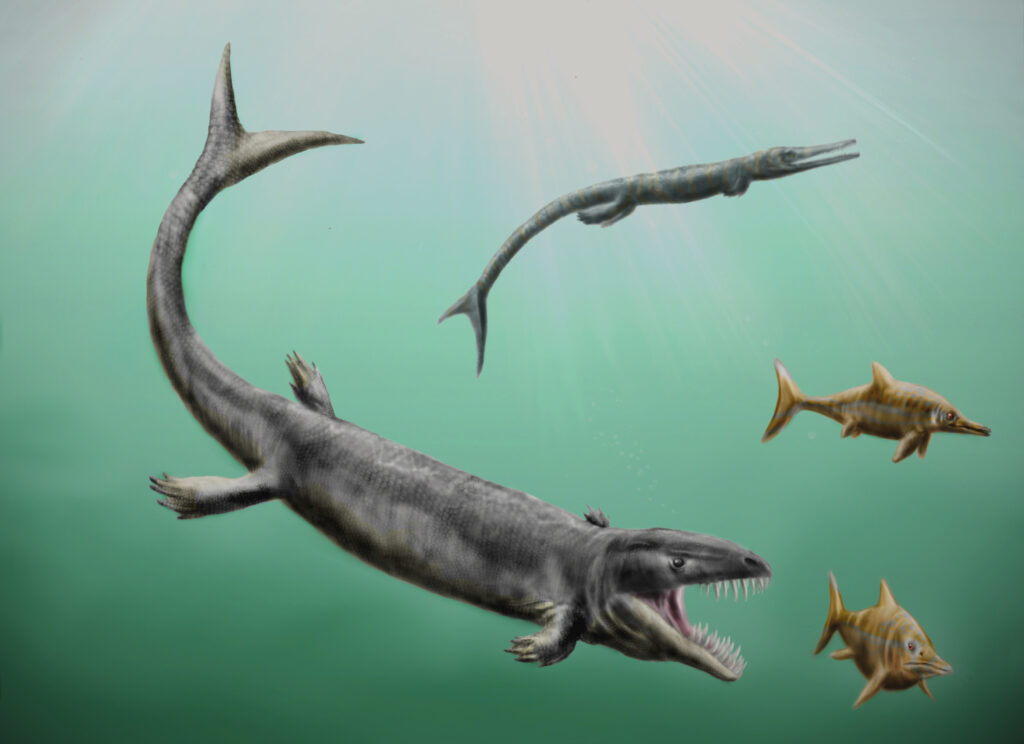
The diversity of swimming dinosaurs reveals fascinating evolutionary patterns that demonstrate how different lineages independently adapted to aquatic environments. The most common adaptations include elongated or laterally compressed tails that provided effective propulsion through water, similar to those seen in modern crocodilians and newts. Sensory adaptations frequently evolved, including pressure-sensitive receptors in the snouts of many swimming dinosaurs that allowed them to detect prey movements underwater without relying solely on vision. Bone density modifications appear consistently across swimming dinosaur species, with many developing denser bones to improve buoyancy control, facilitating diving behaviors. Limb modifications show diverse evolutionary approaches, with some species developing paddle-like limbs while others maintained relatively unmodified limbs but used them differently in water. Interestingly, most swimming dinosaurs maintained some degree of terrestrial capability, suggesting they were semi-aquatic rather than fully aquatic, unlike later marine reptiles like ichthyosaurs or mosasaurs. This pattern of incomplete aquatic adaptation indicates that most swimming dinosaurs exploited the evolutionary advantage of accessing resources in both terrestrial and aquatic environments rather than specializing completely in either.
The Significance of Swimming Dinosaurs
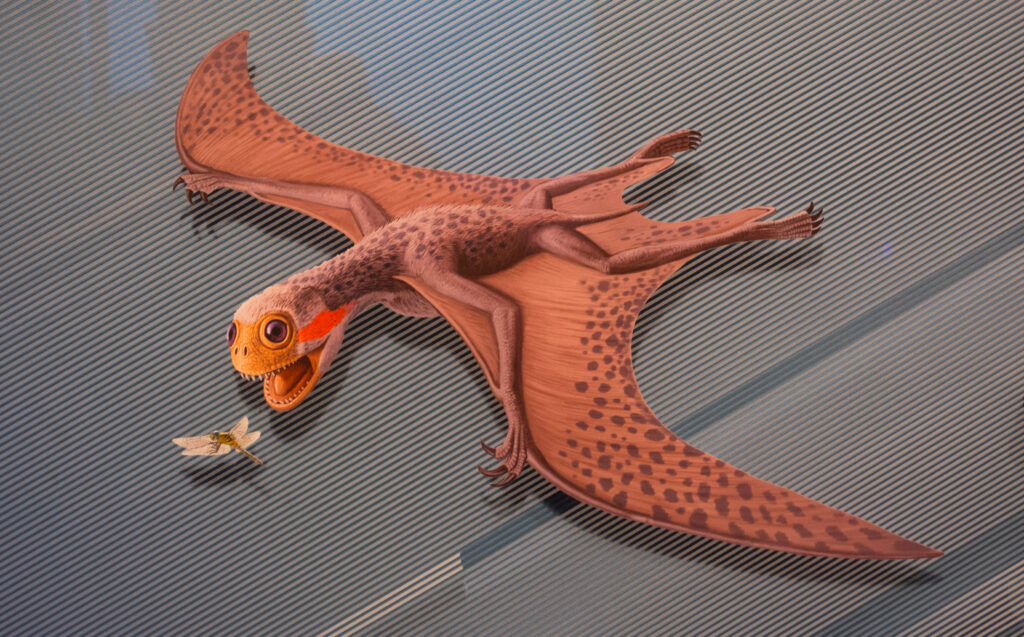
The discovery of numerous swimming dinosaurs has profound implications for our understanding of dinosaur ecology and evolution. These findings fundamentally challenge the traditional view of dinosaurs as exclusively terrestrial animals, revealing a much more complex ecological picture where dinosaurs exploited virtually every available habitat niche, including aquatic environments. Swimming dinosaurs demonstrate remarkable evolutionary convergence with modern semi-aquatic animals, developing similar adaptations despite being separated by millions of years, highlighting how certain environmental pressures consistently produce similar evolutionary solutions. From a biodiversity perspective, the existence of swimming dinosaurs suggests that prehistoric aquatic ecosystems were far more complex than previously understood, with dinosaurs competing alongside crocodilians, pterosaurs, and early birds for aquatic resources. These discoveries also impact our understanding of dinosaur extinction patterns, as semi-aquatic species may have experienced different extinction pressures compared to their fully terrestrial counterparts. Perhaps most significantly, swimming dinosaurs provide a crucial evolutionary link, helping scientists better understand the transition of some dinosaur lineages toward increasingly aquatic lifestyles, eventually leading to the fully aquatic adaptations seen in modern birds like penguins and cormorants.
Conclusion

The discovery and study of swimming dinosaurs have dramatically expanded our understanding of dinosaurian diversity and ecological adaptability. These ten examples represent only a fraction of the species that likely possessed some degree of aquatic capability. From the massive sail-backed Spinosaurus to the tiny four-winged Microraptor, swimming dinosaurs adapted to aquatic environments in remarkably diverse ways across different lineages. These adaptations – specialized limbs, sensory abilities, modified tails, and unique hunting strategies – demonstrate the incredible evolutionary plasticity of dinosaurs. As paleontological techniques continue to advance, we can expect to discover even more examples of swimming dinosaurs, further enriching our understanding of these magnificent creatures that dominated not just the land, but also the waters of the prehistoric world.




